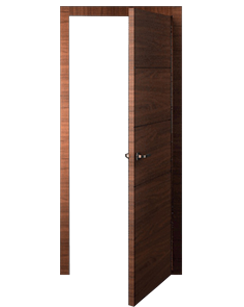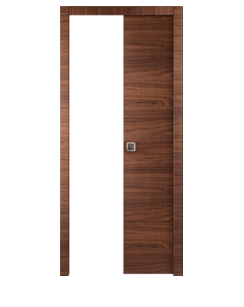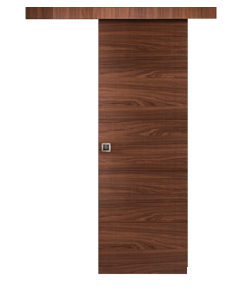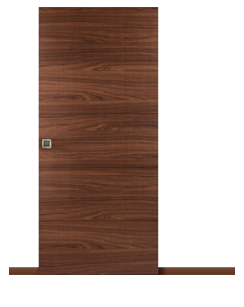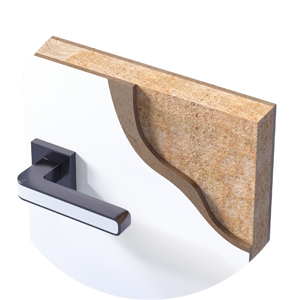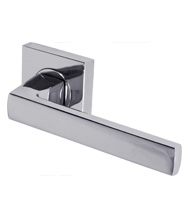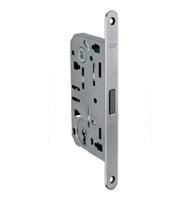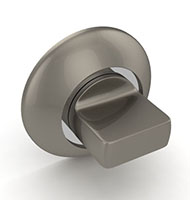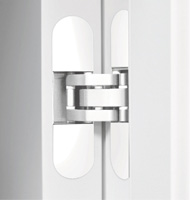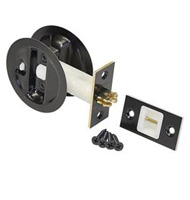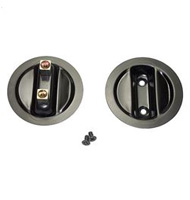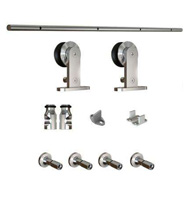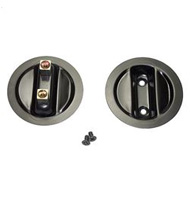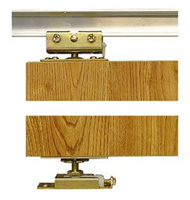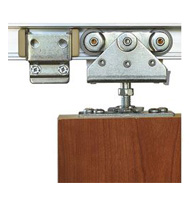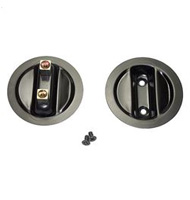
Introduction
Choosing interior doors in an apartment or a house is a multifaceted and complex question. After all, they fulfill essential functions:
-
Play a vital role in the interior.
-
Divide the space.
-
Serve as a decorative element.
Homeowners can't imagine a small room without doors like a studio flat. The suitable model complements the interior style and gives the house a unique look.
What types of doors are there, and what should you pay attention to if you search for interior doors on your own? In this article, we will tell you about everything in order.
Material
Interior doors are made from more than a dozen materials. Therefore, it is best first entirely to explore their pros and cons.
-
Solid wood
Solid wood is the most robust ecological material with high durability. Solid wood doors look expensive and reliable, as reflected in the price.
|
№ |
Wood species |
Characteristics |
|
1. |
Pine |
Pine is a soft wood, so it is easy to work with. It is resistant to high humidity and temperature fluctuations. |
|
2. |
Oak |
Oak is a hardwood species with high thermal and noise insulation values. Durable oak is virtually indestructible over time. |
|
3. |
Ash |
It is a flexible yet durable wood that tolerates dry air well and has a beautiful natural cut pattern. |
|
4. |
Walnut |
Due to its moderate hardness, walnut is resistant to external factors, including rotting, and can be processed well. |
|
5. |
Beech |
Beech is easy to sand and bend. During storage, the dense wood gradually changes hue, becoming a pink-brown material instead of yellowish. |
Solid wood doors are reliable and hard-wearing. However, due to the high cost, some owners prefer other materials. Another significant point is the enormous weight of the structure, which, during installation, will require the installation of an additional hinge.
In general, in the absence of critical temperature and humidity fluctuations, due to which the slab can swell, such doors will last a very long time.
-
MDF
The fiberboard reduces the weight of the product. It also increases its strength and water resistance. The appearance of such doors will depend on the type of coating.
Note that MDF panels are much cheaper than solid wood.
-
Plastic
Plastic doors are easy to care for. But they can look cheap and only suit some interior styles because the primary material is PVC. They are usually put as balcony doors.
-
Glass
Modern glass doors stylishly decorate the space. It is only better to choose tempered, safe glass, which, when broken, does not disintegrate into sharp shards but into parts with blunted edges.
The material requires special care, as the surface is visible with handprints.
-
Mirror
A mirror on the slab is the original way to expand a room visually. Its additional function is practicality: homeowners save space for installation and money on buying a separate mirror, especially if it is installed on the entire door size.
Door Finishing
The most popular options:
-
Enamel: we apply it in several layers at the factory to ensure a perfectly smooth surface and protect the door from scratches, moisture, temperature fluctuations, and color loss.
-
Veneer: these strips of natural wood up to 3 mm thick, glued on top of the MDF panel and covered with a protective varnish.
-
Polypropylene: moisture-resistant material is appropriate in any residential or non-residential space.
-
Eco veneer: a high-quality imitation of wood structure, which can be in various shades.
-
Primer: after installation, the slab can be painted in the color of the walls, wallpapered, or finished with decorative plaster.
-
Eco enamel: its properties are similar to veneer, so the doors look nice and are reliably protected from external factors, including ultraviolet.
-
PVC film: the slabs are not afraid of moisture but lose to other materials in terms of aesthetics.
Design
Several things influence the choice of interior door design simultaneously: the owners' preferences, the apartment style, the renovation budget, whether there are children in the house, etc.
Possible elements of decoration on the slabs:
-
Milling.
-
Aluminum strips.
-
Glass inserts (frosted or clear).
-
Mirror.
For example, glazed doors will fill the room with light, especially if installed opposite the window, and slabs with a mirror will visually increase the area.
Core type
Our factory uses only high-quality and environmentally friendly materials as door filling. So, let's take a closer look at the benefits of each.
-
Solid Core.
Engineered Solid Core is a highly advanced insulating material that boasts a 12.5 lb/ft³ density. It is a modern, innovative door filled with thermal and acoustic insulation.
-
Honeycomb core.
Honeycomb core is a material used in doors that has become popular due to its relatively low price. It is made of pressed cardboard with many hexagonal-shaped cells, resembling a honeycomb in a section.
Door opening systems (configuration)
We offer a variety of configurations, including single swing, double swing, magic, single pocket, double pocket, bi-fold, barn, and bypass.
|
Opening type |
Operating principle |
Advantages |
Disadvantages |
|
Swing and double swing |
Swing doors are a traditional solution for both living rooms and offices. They are easy to open and close in opposite directions thanks to the hinges attached to the slab, making them a convenient element of a house or apartment. For wide openings, double swing doors will be appropriate. |
Ergonomic, good sound insulation. |
The door requires free space to open and close. |
|
Magic |
Sliding doors with a concealed track are an innovative system for saving usable space in a house or apartment. The door moves along the wall, but the entire mechanism is hidden behind the slab. The two closers in the kit smooth the opening and closing process, while the upper and lower rollers with bearings are responsible for the soft and almost silent sliding on the rails. |
Easy to install, neat appearance, ergonomics. |
Reduced heat and noise insulation. |
|
|
The pocket system is a configuration created for small apartments or rooms without classic swing doors. A pocket is a rigid box mounted in the opening, with a sliding system built inside. When opened, the slab slides inside the wall, hiding there. |
Minimalism, space saving, safety (the slab can be left ajar at any level without fear of the door slamming shut) |
Difficult to install, low level of noise insulation. |
|
Barn |
Barn doors are an addition to an industrial, country, or high-tech style room in a sliding system with guides and roller mechanisms in plain sight. The slab, mounted on the top rail, is attached to the wall with two or four rollers. Closers are responsible for smooth and quiet movement. |
Bright accent, compact. |
Not for all interior styles, soundproofing is better with swing doors. |
|
Bi-fold |
The bi-fold system is a solution for saving space. Doors consist of two halves. When opened, each slab folds towards the other, creating the effect of a book unfolding. |
Efficient use of space, non-standard configuration. |
Sound and light leaking through the center seam, limited design and size. |
Door framing
Sometimes, doors and door frames are sold separately, so the latter's quality is also essential.
-
A pre-hung door is already mounted in a frame.
-
On the other hand, a slab door is not mounted in a frame, and you'll need to choose a door frame for it.
-
A door with a concealed frame: frameless doors are the perfect choice for stylish interiors. Thanks to the minimalist, aesthetic, sleek design and the absence of protruding parts, they visually expand the space of a house or apartment.
Frameless primed doors can be painted any shade, wallpapered, or decorated with plaster.
Sizes
For 1-3/4'' thick slabs
|
Slab Width-Height-Thickness |
Unit |
Rough Opening |
|
17-3/4'' x 79-3/8'' x 1-3/4'' |
19-5/16'' x 81-1/4'' x 4-5/8" |
20'' x 81-1/2'' |
|
17-3/4'' x 83-1/4'' x 1-3/4'' |
19-5/16'' x 85-1/8'' x 4-5/8" |
20'' x 85-1/2'' |
|
17-3/4'' x 92-1/2'' x 1-3/4'' |
19-5/16'' x 94-3/8'' x 4-5/8" |
20'' x 94-1/2'' |
|
17-3/4'' x 95-1/4'' x 1-3/4'' |
19-5/16'' x 97-1/8'' x 4-5/8" |
20'' x 97-1/2'' |
|
23-7/8'' x 79-3/8'' x 1-3/4'' |
25-7/16'' x 81-1/4'' x 4-5/8" |
26'' x 81-1/2'' |
|
23-7/8'' x 83-1/4'' x 1-3/4'' |
25-7/16'' x 85-1/8'' x 4-5/8" |
26'' x 85-1/2'' |
|
23-7/8'' x 92-1/2'' x 1-3/4'' |
25-7/16'' x 94-3/8'' x 4-5/8" |
26'' x 94-1/2'' |
|
23-7/8'' x 95-1/4'' x 1-3/4'' |
25-7/16'' x 97-1/8'' x 4-5/8" |
26'' x 97-1/2'' |
|
27-3/4'' x 79-3/8'' x 1-3/4'' |
29-5/16'' x 81-1/4'' x 4-5/8" |
30'' x 81-1/2'' |
|
27-3/4'' x 83-1/4'' x 1-3/4'' |
29-5/16'' x 85-1/8'' x 4-5/8" |
30'' x 85-1/2'' |
|
27-3/4'' x 92-1/2'' x 1-3/4'' |
29-5/16'' x 94-3/8'' x 4-5/8" |
30'' x 94-1/2'' |
|
27-3/4'' x 95-1/4'' x 1-3/4'' |
29-5/16'' x 97-1/8'' x 4-5/8" |
30'' x 97-1/2'' |
|
29-3/4'' x 79-3/8'' x 1-3/4'' |
31-5/16'' x 81-1/4'' x 4-5/8" |
32'' x 81-1/2'' |
|
29-3/4'' x 83-1/4'' x 1-3/4'' |
31-5/16'' x 85-1/8'' x 4-5/8" |
32'' x 85-1/2'' |
|
29-3/4'' x 92-1/2'' x 1-3/4'' |
31-5/16'' x 94-3/8'' x 4-5/8" |
32'' x 94-1/2'' |
|
29-3/4'' x 95-1/4'' x 1-3/4'' |
31-5/16'' x 97-1/8'' x 4-5/8" |
32'' x 97-1/2'' |
|
31-3/4'' x 79-3/8'' x 1-3/4'' |
33-5/16'' x 81-1/4'' x 4-5/8" |
34'' x 81-1/2'' |
|
31-3/4'' x 83-1/4'' x 1-3/4'' |
33-5/16'' x 85-1/8'' x 4-5/8" |
34'' x 85-1/2'' |
|
31-3/4'' x 92-1/2'' x 1-3/4'' |
33-5/16'' x 94-3/8'' x 4-5/8" |
34'' x 94-1/2'' |
|
31-3/4'' x 95-1/4'' x 1-3/4'' |
33-5/16'' x 97-1/8'' x 4-5/8" |
34'' x 97-1/2'' |
|
35-7/8'' x 83-1/4'' x 1-3/4'' |
37-7/16'' x 85-1/8'' x 4-5/8" |
38'' x 81-1/2'' |
|
35-7/8'' x 79-3/8'' x 1-3/4'' |
37-7/16'' x 81-1/4'' x 4-5/8" |
38'' x 85-1/2'' |
|
35-7/8'' x 92-1/2'' x 1-3/4'' |
37-7/16'' x 94-3/8'' x 4-5/8" |
38'' x 94-1/2'' |
|
35-7/8'' x 95-1/4'' x 1-3/4'' |
37-7/16'' x 97-1/8'' x 4-5/8" |
38'' x 97-1/2'' |
For 1-9/16'' thick slabs
|
Slab Width-Height-Thickness |
Unit |
Rough Opening |
|
17-3/4'' x 79-3/8'' x 1-9/16'' |
19-5/16'' x 81-1/4'' x 4-5/8" |
20'' x 81-1/2'' |
|
17-3/4'' x 83-1/4'' x 1-9/16'' |
19-5/16'' x 85-1/8'' x 4-5/8" |
20'' x 85-1/2'' |
|
17-3/4'' x 92-1/2'' x 1-9/16'' |
19-5/16'' x 94-3/8'' x 4-5/8" |
20'' x 94-1/2'' |
|
17-3/4'' x 95-1/4'' x 1-9/16'' |
19-5/16'' x 97-1/8'' x 4-5/8" |
20'' x 97-1/2'' |
|
23-7/8'' x 79-3/8'' x 1-9/16'' |
25-7/16'' x 81-1/4'' x 4-5/8" |
26'' x 81-1/2'' |
|
23-7/8'' x 83-1/4'' x 1-9/16'' |
25-7/16'' x 85-1/8'' x 4-5/8" |
26'' x 85-1/2'' |
|
23-7/8'' x 92-1/2'' x 1-9/16'' |
25-7/16'' x 94-3/8'' x 4-5/8" |
26'' x 94-1/2'' |
|
23-7/8'' x 95-1/4'' x 1-9/16'' |
25-7/16'' x 97-1/8'' x 4-5/8" |
26'' x 97-1/2'' |
|
27-3/4'' x 79-3/8'' x 1-9/16'' |
29-5/16'' x 81-1/4'' x 4-5/8" |
30'' x 81-1/2'' |
|
27-3/4'' x 83-1/4'' x 1-9/16'' |
29-5/16'' x 85-1/8'' x 4-5/8" |
30'' x 85-1/2'' |
|
27-3/4'' x 92-1/2'' x 1-9/16'' |
29-5/16'' x 94-3/8'' x 4-5/8" |
30'' x 94-1/2'' |
|
27-3/4'' x 95-1/4'' x 1-9/16'' |
29-5/16'' x 97-1/8'' x 4-5/8" |
30'' x 97-1/2'' |
|
29-3/4'' x 79-3/8'' x 1-9/16'' |
31-5/16'' x 81-1/4'' x 4-5/8" |
32'' x 81-1/2'' |
|
29-3/4'' x 83-1/4'' x 1-9/16'' |
31-5/16'' x 85-1/8'' x 4-5/8" |
32'' x 85-1/2'' |
|
29-3/4'' x 92-1/2'' x 1-9/16'' |
31-5/16'' x 94-3/8'' x 4-5/8" |
32'' x 94-1/2'' |
|
29-3/4'' x 95-1/4'' x 1-9/16'' |
31-5/16'' x 97-1/8'' x 4-5/8" |
32'' x 97-1/2'' |
|
31-3/4'' x 79-3/8'' x 1-9/16'' |
33-5/16'' x 81-1/4'' x 4-5/8" |
34'' x 81-1/2'' |
|
31-3/4'' x 83-1/4'' x 1-9/16'' |
33-5/16'' x 85-1/8'' x 4-5/8" |
34'' x 85-1/2'' |
|
31-3/4'' x 92-1/2'' x 1-9/16'' |
33-5/16'' x 94-3/8'' x 4-5/8" |
34'' x 94-1/2'' |
|
31-3/4'' x 95-1/4'' x 1-9/16'' |
33-5/16'' x 97-1/8'' x 4-5/8" |
34'' x 97-1/2'' |
|
35-7/8'' x 79-3/8'' x 1-9/16'' |
37-7/16'' x 81-1/4'' x 4-5/8" |
38'' x 81-1/2'' |
|
35-7/8'' x 83-1/4'' x 1-9/16'' |
37-7/16'' x 85-1/8'' x 4-5/8" |
38'' x 85-1/2'' |
|
35-7/8'' x 92-1/2'' x 1-9/16'' |
37-7/16'' x 94-3/8'' x 4-5/8" |
38'' x 94-1/2'' |
|
35-7/8'' x 95-1/4'' x 1-9/16'' |
37-7/16'' x 97-1/8'' x 4-5/8" |
38'' x 97-1/2'' |
Door sound ratings
The STC (sound transmission class) is required when purchasing an interior door. If the STC number is lower, more sound passes through the slab.
The STC number must be 60 or higher for the door to protect you from extraneous sounds reliably.
Our interior doors have a solid core, which provides exceptional soundproofing.
Door Hardware
Besides the design of the hardware, don't forget to consider:
-
Color.
-
Functionality.
-
Quality.
It should match the doors and the style of the apartment. For example, handles and hinges of bronze or gold are suitable for a classic interior, and chrome or stainless steel for a modern one.
Conclusions
Before buying doors, you should consider the material, design, dimensions, opening system, the size of the room, and its purpose. In addition, compare price and quality to ensure that your new pieces of furniture will last as long as possible.
We are confident in the quality of our products, so each model of interior doors is covered by a 2-year warranty. Please get in touch with our call center for a free consultation and to choose the ideal option for your home or apartment.

